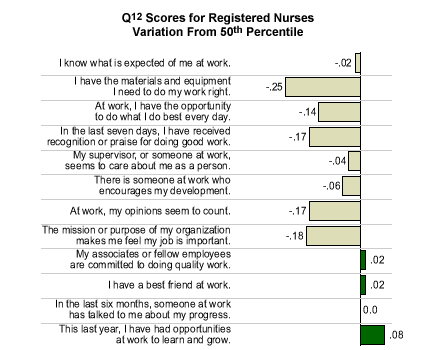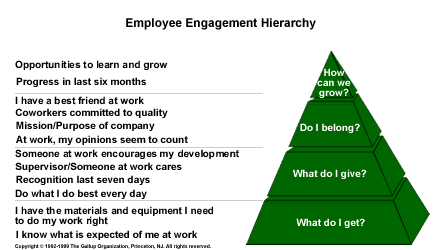The fourth article in a multipart series on healthcare job categories
The acute nature of the nursing shortage in America is no secret, and low employee engagement scores among RNs may be among the consequences. Registered nurses score below the 50th percentile for healthcare employees on employee engagement, according to Gallup's database of Q12 engagement results. In fact, RNs and licensed technical staff have the lowest engagement scores of the five categories we tested within the healthcare field (the other three categories are administrative/clerical staff, professionals, and support staff).
To those employed in healthcare, the fact that RNs are relatively unlikely to be fully engaged with their jobs probably isn't surprising. Some of the reasons behind the low scores are as obvious as the nursing shortage, but perhaps the real surprises appear within RNs' scores on individual Q12 question items.
RNs score at or above the 50th percentile for healthcare employees on four of the 12 employee engagement items, and below the 50th percentile on eight of the items.

Clearly, there is significant room for improvement on each item. But it is not only the individual low-scoring items themselves that are troubling, but also the pattern in which the low scores occur.
Nursing's Revolving Door
The item which nurses are most likely to rate lower than other healthcare workers in the database is: "I have the materials and equipment I need to do my work right." On Gallup's employee engagement model, that question is near the base of the pyramid, while the four items rated most highly by nurses are the four at the top of the pyramid. Through decades of workplace research, Gallup has determined that to achieve strong employee engagement, workgroups must establish a strong foundation through high scores at the base of the pyramid, then work their way up to high scores on the items above.

As discussed previously (see "Employee Engagement: Where Do Hospitals Begin? Part II"), low scores at the base of the pyramid and high scores at the top are indicative of a "train for the road" phenomenon among nurses. Disengaged nurses tend develop their skills and expertise with one employer, but are constantly looking to take that expertise elsewhere. The obvious outcome: high turnover. In turn, low retention drives down scores on the "materials and equipment" item, which nurses tend to associate with a dearth of available manpower.
But even jumping ship may not improve the situation for many unhappy nurses; because the nursing shortage afflicts most healthcare organizations across the country, they are likely to encounter the same problems wherever they go.
Can the Cycle Be Broken?
This scenario may seem extreme, but at many hospitals it is reality. However, some workgroups do manage to achieve exceptional outcomes. What makes the difference?
Gallup's best-practice studies indicate that the biggest difference lies with the manager/supervisor. Managers of the most successful nursing units not only open their doors so their employees can come to them, but also leave their offices to visit employees in their own working environments. They manage by wandering. They talk to their employees and listen to what they have to say. They find out not only about their team members' work issues, but also about their personal lives. They don't just seek out their happy employees, but also talk to the unhappy ones and allow them to "vent." In short, great managers care.
It's extremely difficult for caring managers to be framed as "them" in an "us-versus-them" scenario. Great managers cannot make all the problems in nursing go away, but they can make their own units better places to work.
The Q12 items are protected by copyright of The Gallup Organization, Princeton, N.J., 1992-1999. All rights reserved.